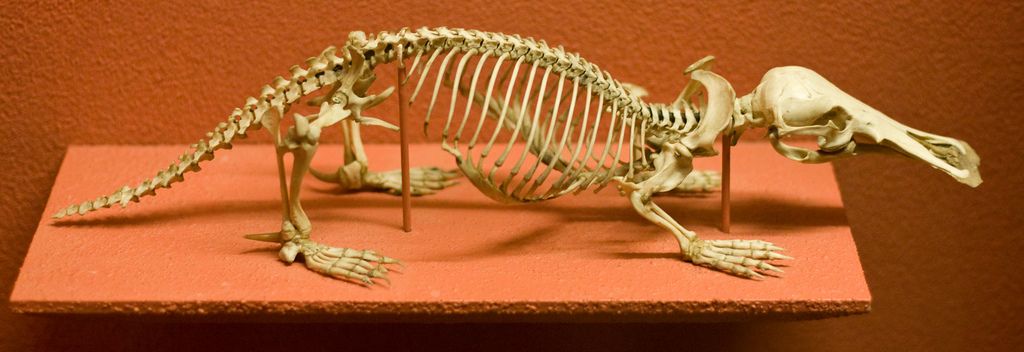The platypus, often dubbed as nature’s eccentric masterpiece, is a creature that continues to captivate scientists and enthusiasts alike. This semi-aquatic monotreme boasts a unique combination of features, blending mammalian, avian, and reptilian traits in a perplexing mosaic of adaptations. Among the many mysteries surrounding the platypus, its skeletal structure stands out as a testament to evolutionary ingenuity. In this article, we embark on a journey to unravel the enigmatic intricacies of the platypus skeleton, delving into its evolutionary significance, anatomical peculiarities, and adaptive marvels.
Evolutionary Origins
Understanding the platypus skeleton necessitates a glimpse into its evolutionary lineage. As a monotreme, the platypus shares ancestry with ancient mammalian predecessors, diverging from the mainstream mammalian evolutionary trajectory millions of years ago. The skeleton of the platypus bears witness to this evolutionary divergence, embodying a mosaic of primitive and derived traits that reflect its unique evolutionary journey.
Skull
At the forefront of the platypus’s skeletal marvels lies its skull, a testament to its evolutionary legacy. The platypus skull presents a fusion of reptilian and mammalian features, offering insights into its distant ancestors. Key features include:
Bill Structure: The most conspicuous feature of the platypus skull is its distinctive bill, reminiscent of a duck’s beak. However, unlike a bird’s beak, the platypus bill is not made of keratin but instead comprises a leathery skin covering over a framework of bones, equipped with electroreceptors used for detecting prey underwater.
Sensory Adaptations: Embedded within the bill are numerous mechanoreceptors and electroreceptors, facilitating the platypus’s remarkable ability to detect electric fields generated by its aquatic prey. This sensory adaptation is unparalleled among mammals and underscores the platypus’s evolutionary divergence.
Temporal Fenestration: Another intriguing aspect of the platypus skull is the presence of temporal fenestrae, openings in the skull behind the eyes. These fenestrae, reminiscent of reptilian skulls, serve as attachment sites for jaw muscles and contribute to the platypus’s unique chewing mechanism.
Postcranial Skeleton
Beyond the skull, the platypus’s postcranial skeleton offers further insights into its semi-aquatic lifestyle and evolutionary adaptations. From its robust limbs to its flexible spine, every aspect of the platypus’s postcranial skeleton reflects its unique ecological niche. Key adaptations include:
Forelimbs and Webbed Feet: The forelimbs of the platypus are equipped with webbed feet, ideal for navigating its aquatic habitat with agility and precision. These webbed appendages, reminiscent of those found in amphibians and waterfowl, enable the platypus to propel itself through water with remarkable efficiency.
Spine and Tail: The spine of the platypus exhibits remarkable flexibility, allowing for efficient swimming and maneuvering in aquatic environments. Additionally, the platypus possesses a long, muscular tail, which serves as a rudder during swimming and aids in maintaining balance.
Pelvic Girdle: Unlike most mammals, the platypus lacks a pelvic symphysis, or fusion of the pelvic bones, allowing for increased flexibility and mobility in its hindquarters. This adaptation facilitates the platypus’s unique mode of locomotion, characterized by powerful strokes of its hind limbs.
Reproductive Adaptations
In addition to its locomotor adaptations, the platypus skeleton also exhibits specialized features related to reproduction, further distinguishing it from other mammals. As a monotreme, the platypus lays eggs rather than giving birth to live young, a reproductive strategy that is reflected in its skeletal anatomy. Key reproductive adaptations include:
Pelvic Spurs: Male platypuses possess venomous spurs on their hind limbs, a feature absent in females. These spurs, connected to venom glands, play a role in competition and mate selection, underscoring the evolutionary significance of reproductive adaptations in the platypus.
Cloaca: Both male and female platypuses possess a cloaca, a single opening used for excretion, mating, and egg-laying. This anatomical feature reflects the primitive reproductive anatomy shared by monotremes and underscores the platypus’s evolutionary antiquity.
Conclusion
The platypus skeleton stands as a testament to the evolutionary ingenuity of this enigmatic creature. From its reptilian-like skull to its specialized postcranial adaptations, every aspect of the platypus skeleton reflects its unique evolutionary history and ecological niche. By unraveling the intricacies of the platypus skeleton, scientists gain valuable insights into the evolutionary processes that have shaped life on Earth. As we continue to explore and study this fascinating creature, we deepen our understanding of the marvels of nature and the myriad ways in which life adapts to thrive in diverse environments.







